Unifi Bundle
How Does Unifi Thrive in a Crowded Market?
Unifi, a pioneer in sustainable textiles, has carved a significant niche in an industry increasingly focused on environmental responsibility. Founded in 1971, the company has evolved from a texturizer of polyester yarns to a global leader, particularly known for its REPREVE® brand. This transformation highlights Unifi's commitment to innovation and its ability to adapt to changing market dynamics, making it a compelling case study for any business strategist.
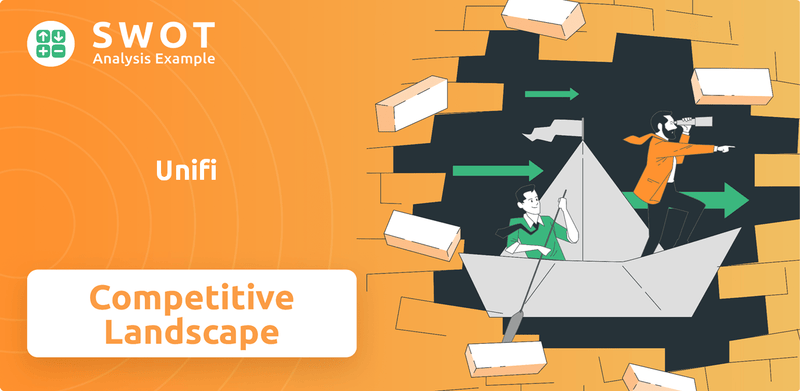
Understanding the Unifi SWOT Analysis is crucial to grasping its position within the Unifi competitive landscape. This exploration delves into Unifi's business strategy, analyzing its key Unifi competitors and the broader Unifi industry analysis to determine its market share. We'll examine Unifi's growth strategies and challenges while providing insights into the latest Unifi market trends. This analysis will also cover Unifi's competitive advantages and disadvantages, providing a comprehensive view of its market position.
Where Does Unifi’ Stand in the Current Market?
Unifi, Inc. holds a significant market position within the global textile industry, particularly in recycled and performance fibers. The company is recognized as a leader in sustainable textile solutions, primarily through its REPREVE® brand. This brand is a benchmark for recycled fibers, serving major global brands in the apparel, footwear, automotive, and home furnishings sectors. Unifi's primary product lines include REPREVE® recycled fibers and a range of other synthetic and performance yarns.
Unifi's strategic focus on sustainability has allowed it to capture a growing segment of the market driven by consumer demand for sustainable products. The company's global presence, with manufacturing facilities and sales operations across North America, South America, Asia, and Europe, enables it to serve a broad customer base and adapt to regional market demands. Unifi's business strategy has evolved to emphasize sustainability and innovation, moving beyond traditional yarn texturizing to become a solutions provider.
For the third fiscal quarter of 2024, Unifi reported net sales of $143.0 million. While this represents a decrease compared to the prior year, the company's gross margin increased to 8.2% from 7.0%, indicating improved operational efficiency. The company's focus on cost management and operational improvements is evident in its financial reporting. Unifi's strong position in the recycled fiber market is further solidified by its long-standing relationships with major brands and its continuous investment in research and development to expand its sustainable product offerings.
Unifi's market share is substantial within the recycled and performance fiber segments. The company's REPREVE® brand is a key driver of its market position. Unifi's competitive landscape includes various players in the textile industry.
Unifi has a strong global presence with manufacturing and sales operations across North America, South America, Asia, and Europe. This extensive reach allows Unifi to serve a broad customer base. This global footprint supports its competitive advantages.
In the third fiscal quarter of 2024, Unifi reported net sales of $143.0 million. Gross margin improved to 8.2% from 7.0% year-over-year. The company is focused on cost management and operational improvements.
Unifi's business strategy emphasizes sustainability and innovation, moving beyond traditional yarn texturizing. The company aims to be a solutions provider for brands seeking environmentally responsible materials. Unifi's competitive landscape is shaped by this strategic direction.
Unifi's strengths include its REPREVE® brand and global presence. Weaknesses may include dependence on market conditions and raw material costs. The company's market analysis shows its ability to adapt.
- Strengths: Strong brand recognition (REPREVE®), global presence, focus on sustainability.
- Weaknesses: Dependence on market demand, raw material price volatility, and competition.
- Opportunities: Growing demand for sustainable products, expansion into new markets, and innovation in fiber technology.
- Threats: Economic downturns, increased competition, and changes in consumer preferences.
Unifi SWOT Analysis
- Complete SWOT Breakdown
- Fully Customizable
- Editable in Excel & Word
- Professional Formatting
- Investor-Ready Format
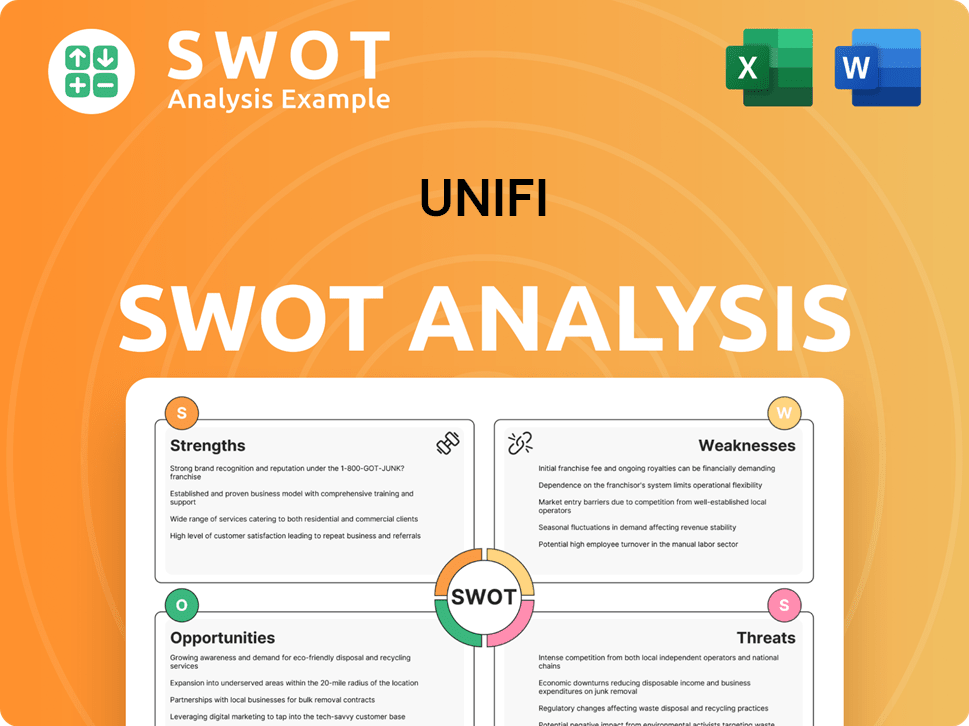
Who Are the Main Competitors Challenging Unifi?
The Unifi competitive landscape is shaped by a global textile industry, marked by both established and emerging players. These competitors are involved in the synthetic and recycled fiber segments, with direct rivals producing similar yarns for various markets. This includes apparel, automotive, and home goods, often involving large chemical and textile corporations with significant global reach.
A thorough Unifi market analysis reveals that the competitive environment is dynamic, influenced by factors such as pricing, product innovation, and brand recognition. Mergers and alliances within the textile and chemical industries can shift competitive dynamics, creating larger, more formidable rivals or new strategic partnerships. Unifi's business strategy must therefore consider these evolving market conditions.
Indorama Ventures is a significant global producer of PET and polyester fibers. They have a strong presence in recycled PET (rPET) and offer a wide range of sustainable solutions, directly competing with Unifi's REPREVE® brand.
Reliance Industries, particularly its polyester division, is a major global producer of polyester fibers and yarns. Their scale and market dominance in virgin polyester can indirectly impact Unifi by influencing overall market pricing and material availability.
Hyosung TNC Corporation, with its creora® elastane and regen® recycled fibers, presents strong competition. Their focus on innovative performance attributes and sustainable offerings directly overlaps with Unifi's product development goals.
These companies often focus on niche markets or specific waste streams. They can challenge Unifi through rapid innovation, specialized technologies, or localized supply chains.
The competition involves battles over price, product innovation, brand recognition, and securing long-term contracts. The Unifi industry analysis demonstrates that understanding these competitors is crucial for developing effective strategies. For more insights, you can read an article about Unifi's competitive positioning and strategies to attract and retain customers.
Several factors influence the competitive dynamics in the synthetic and recycled fiber markets. These include:
- Pricing strategies and cost competitiveness.
- Product innovation, including enhanced performance features and new recycling technologies.
- Brand recognition and marketing of sustainable offerings.
- Ability to secure long-term contracts with major global brands.
- Supply chain efficiency and global reach.
Unifi PESTLE Analysis
- Covers All 6 PESTLE Categories
- No Research Needed – Save Hours of Work
- Built by Experts, Trusted by Consultants
- Instant Download, Ready to Use
- 100% Editable, Fully Customizable
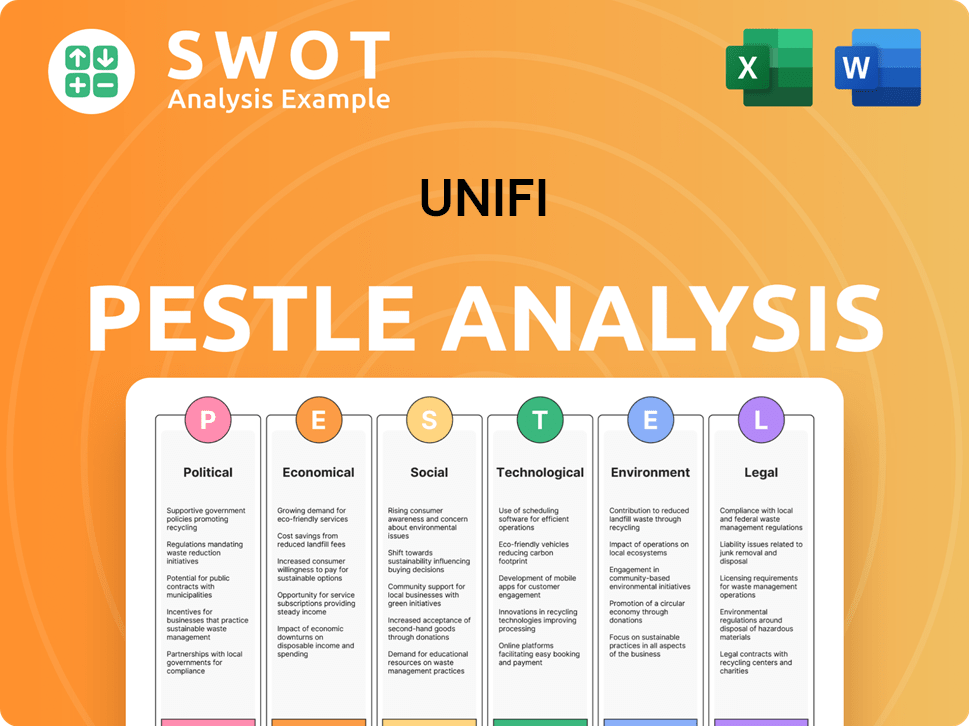
What Gives Unifi a Competitive Edge Over Its Rivals?
Understanding the competitive landscape of a company involves assessing its key strengths and how it differentiates itself from rivals. For Unifi, this means examining its proprietary technologies, brand recognition, and commitment to sustainability. This analysis is crucial for investors, strategists, and industry analysts seeking to understand its market position and future prospects. The competitive advantages are often the cornerstone of a company's success, driving market share and profitability.
A deep dive into the competitive advantages of Unifi reveals a strategic focus on innovation, intellectual property, and customer relationships. These factors contribute to its ability to maintain a strong position in the market. Unifi's approach to sustainability, particularly through its REPREVE® platform, also plays a significant role in shaping its competitive edge. This focus on sustainability is increasingly important in today's market.
The company's core competitive advantages are rooted in its proprietary technologies, strong brand equity, and commitment to sustainability, especially through its REPREVE® platform. The most significant advantage is its REPREVE® brand, which has become synonymous with high-quality recycled performance fibers. This brand recognition is a direct result of Unifi's advanced recycling technologies that transform plastic bottles and other waste materials into premium fibers, offering superior performance characteristics.
REPREVE® is a leading brand in recycled performance fibers, recognized globally. This recognition stems from Unifi's advanced recycling technologies. The brand's association with sustainability and high performance gives it a competitive edge.
Unifi's patented processes for fiber extrusion and texturizing ensure consistent quality and performance. These technologies set its products apart from generic recycled alternatives. Intellectual property, including numerous patents, strengthens Unifi's market position.
Unifi has built customer loyalty through long-standing relationships with global brands. These brands value Unifi's commitment to sustainability and reliable supply chain. Consistent delivery of high-performance, verifiable recycled content helps brands meet their sustainability goals.
Unifi's global manufacturing footprint and distribution network provide economies of scale and efficient delivery. This enables it to serve a diverse international clientele. These advantages have evolved from a focus on traditional yarn processing to a leadership position in sustainable textile solutions.
Unifi's competitive advantages are multifaceted, including brand recognition, proprietary technology, and customer loyalty. These strengths are crucial for its success in the market. The company's focus on sustainability, particularly with its REPREVE® brand, is a key differentiator.
- REPREVE® Brand: Synonymous with high-quality, recycled performance fibers.
- Proprietary Technologies: Patented processes for fiber extrusion and texturizing.
- Customer Relationships: Long-standing relationships with global brands.
- Global Footprint: Economies of scale and efficient delivery.
Unifi Business Model Canvas
- Complete 9-Block Business Model Canvas
- Effortlessly Communicate Your Business Strategy
- Investor-Ready BMC Format
- 100% Editable and Customizable
- Clear and Structured Layout
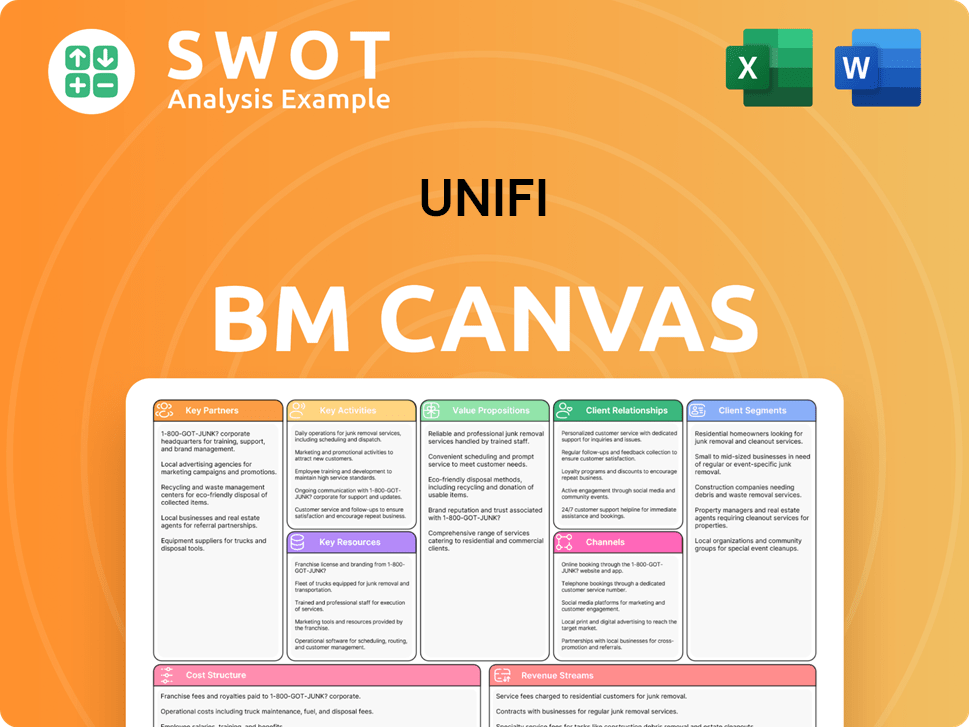
What Industry Trends Are Reshaping Unifi’s Competitive Landscape?
The textile industry is undergoing a significant transformation, with the competitive landscape of Unifi being shaped by evolving trends. These trends present both challenges and opportunities for companies like Unifi. A key factor is the increasing demand for sustainable and circular solutions, which is driving innovation in recycled materials and responsible production. This shift directly impacts Unifi's market position with its REPREVE® brand.
Technological advancements in fiber science and manufacturing, including digitalization and automation, are also reshaping the industry. Regulatory changes, particularly in regions like the European Union, are promoting textile recycling and extended producer responsibility. Global economic shifts, such as inflationary pressures and supply chain disruptions, continue to influence raw material costs and production stability. These factors are crucial in assessing Unifi's competitive landscape and its future market share.
Key trends include rising demand for sustainable materials and circular solutions, technological advancements in fiber science, and regulatory changes promoting textile recycling. These trends are crucial for understanding the Unifi industry analysis and its future. The shift towards eco-friendly materials is particularly significant.
Unifi faces challenges from new market entrants offering alternative sustainable materials. Declining demand in certain textile segments and global economic shifts, including inflation and supply chain issues, also pose risks. These factors directly affect Unifi's competitive landscape and its business strategy.
Significant growth opportunities exist in emerging markets and through innovations in product development. Strategic partnerships and expansion into new application areas can also drive growth. These opportunities are vital for Unifi's future plans and expansion strategies.
Unifi's strategy should emphasize continuous innovation, operational efficiency, and strategic collaborations. The company's focus should be on advanced sustainable materials and deeper integration into circular supply chains. Understanding Unifi's market share is crucial for its strategic direction.
Unifi's competitive landscape is evolving due to industry trends and market dynamics. The company's ability to adapt to these changes will determine its success. For example, in the third fiscal quarter of 2024, Unifi experienced decreased average selling prices, which impacted net sales, despite improved sales volumes.
- Sustainable Materials Demand: The increasing demand for sustainable materials is a significant opportunity.
- Technological Advancements: Adoption of new technologies in manufacturing can enhance efficiency.
- Market Expansion: Emerging markets offer significant growth potential.
- Strategic Partnerships: Collaborations can strengthen Unifi's position.
Unifi Porter's Five Forces Analysis
- Covers All 5 Competitive Forces in Detail
- Structured for Consultants, Students, and Founders
- 100% Editable in Microsoft Word & Excel
- Instant Digital Download – Use Immediately
- Compatible with Mac & PC – Fully Unlocked
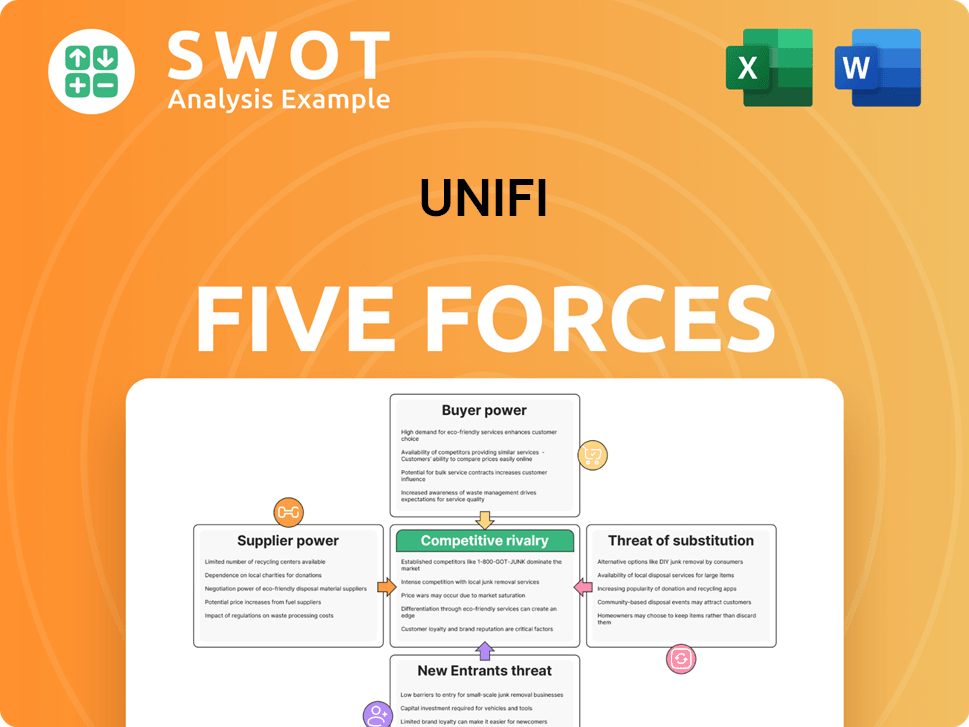
Related Blogs
- What are Mission Vision & Core Values of Unifi Company?
- What is Growth Strategy and Future Prospects of Unifi Company?
- How Does Unifi Company Work?
- What is Sales and Marketing Strategy of Unifi Company?
- What is Brief History of Unifi Company?
- Who Owns Unifi Company?
- What is Customer Demographics and Target Market of Unifi Company?
Disclaimer
All information, articles, and product details provided on this website are for general informational and educational purposes only. We do not claim any ownership over, nor do we intend to infringe upon, any trademarks, copyrights, logos, brand names, or other intellectual property mentioned or depicted on this site. Such intellectual property remains the property of its respective owners, and any references here are made solely for identification or informational purposes, without implying any affiliation, endorsement, or partnership.
We make no representations or warranties, express or implied, regarding the accuracy, completeness, or suitability of any content or products presented. Nothing on this website should be construed as legal, tax, investment, financial, medical, or other professional advice. In addition, no part of this site—including articles or product references—constitutes a solicitation, recommendation, endorsement, advertisement, or offer to buy or sell any securities, franchises, or other financial instruments, particularly in jurisdictions where such activity would be unlawful.
All content is of a general nature and may not address the specific circumstances of any individual or entity. It is not a substitute for professional advice or services. Any actions you take based on the information provided here are strictly at your own risk. You accept full responsibility for any decisions or outcomes arising from your use of this website and agree to release us from any liability in connection with your use of, or reliance upon, the content or products found herein.